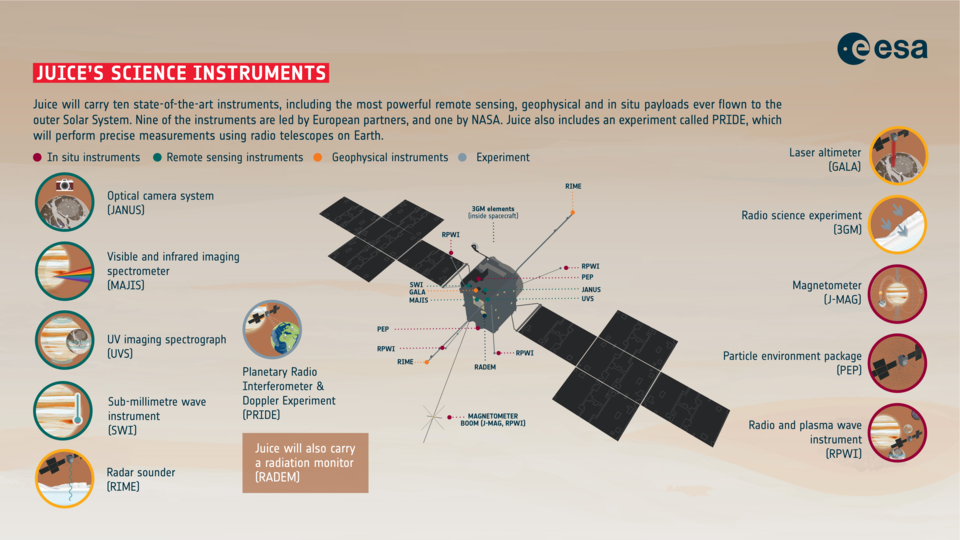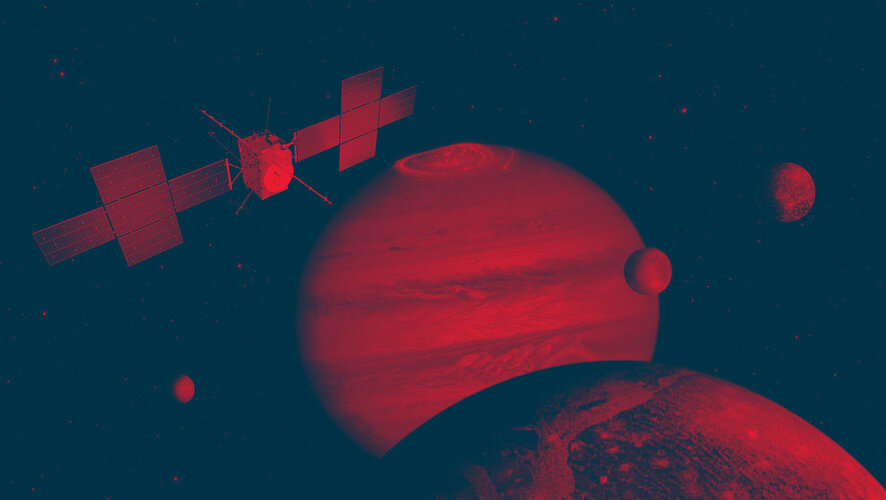Juice rerouted to Venus in world’s first lunar-Earth flyby
ESA’s Jupiter Icy Moons Explorer (Juice) has successfully completed a world-first lunar-Earth flyby, using the gravity of Earth to send it Venus-bound, on a shortcut to Jupiter through the inner Solar System.
The closest approach to the Moon was at 23:15 CEST (21:15 UTC) on 19 August, guiding Juice towards a closest approach to Earth just over 24 hours later at 23:56 CEST (21:56 UTC) on 20 August.
As Juice flew just 6840 km above Southeast Asia and the Pacific Ocean, it snapped a series of images with its onboard monitoring cameras, and collected scientific data with eight of its ten instruments.
“The gravity assist flyby was flawless, everything went without a hitch, and we were thrilled to see Juice coming back so close to Earth,” says Ignacio Tanco, Spacecraft Operations Manager for the mission.
The purpose of the flyby was to reroute Juice’s path through space, using the gravity of first the Moon and then Earth to change the spacecraft’s speed and direction.

The flyby of the Moon increased Juice’s speed by 0.9 km/s relative to the Sun, guiding Juice towards Earth. The flyby of Earth reduced Juice’s speed by 4.8 km/s relative to the Sun, guiding Juice onto a new trajectory towards Venus. Overall, the lunar-Earth flyby deflected Juice by an angle of 100° compared to its pre-flyby path.
The inherently risky flyby required ultra-precise, real-time navigation, but is saving the mission around 100–150 kg of fuel. In the month before the flyby, spacecraft operators gave Juice slight nudges to put it on exactly the right approach trajectory. Then they tracked Juice 24/7 between 17–22 August.
Thanks to a flawless Ariane 5 launch back in April 2023, Juice has a little extra propellant in its tanks to get closer to Jupiter’s moon Ganymede than originally planned. The success of the lunar-Earth flyby has safeguarded this bonus science.
“Thanks to very precise navigation by ESA’s Flight Dynamics team, we managed to use only a tiny fraction of the propellant reserved for this flyby. This will add to the margins we keep for a rainy day, or to extend the science mission once we get to Jupiter,” adds Ignacio.

A first taste of science in space
Whilst the main goal was to alter Juice’s trajectory, the lunar-Earth flyby also provided an opportunity to test out Juice’s scientific instruments in space, with all ten switched on during the Moon flyby, and eight switched on during the Earth flyby.
We expect to publish images and spectra collected by some of Juice’s instruments in the next weeks, as they are downlinked from the spacecraft and evaluated by the instrument scientists. This includes high-resolution images on the Moon and Earth from Juice’s scientific camera, JANUS.
“The timing and location of this double flyby allows us to thoroughly study the behaviour of Juice’s instruments,” explains Claire Vallat, Juice Operations Scientist.
“It happens early enough in Juice’s journey that we can use the data to prepare the instruments for arrival at Jupiter. And given how well we know the physical properties of Earth, the Moon, and the surrounding space environment, it’s also the ideal location to understand how the instruments respond to a real target.”

Next step: Venus
This lunar-Earth flyby actually reduced Juice’s energy, redirecting it towards a meeting with Venus in August 2025. That Venus flyby will boost Juice back out towards Earth; the spacecraft will fly by our home planet again in September 2026 and January 2029, gaining two more boosts before arrival at Jupiter in July 2031.

For more information about Juice’s lunar-Earth flyby, including why and how we use gravity assist flybys to reach the inner and outer Solar System, see Juice’s lunar-Earth flyby: all you need to know.
Delve deeper into the story of Juice’s lunar-Earth flyby with our Rocket Science blog.
Follow @ESA_Juice on X for all the latest mission updates.
Relive the Moon flyby with ESA’s livestream, including a Q&A with the mission experts, on ESA’s YouTube channel.
About Juice
ESA’s Jupiter Icy Moons Explorer, ‘Juice’, is humankind’s next bold mission to the outer Solar System. It will make detailed observations of gas giant Jupiter and its three large ocean-bearing moons – Ganymede, Callisto and Europa. This ambitious mission will characterise these moons with a powerful suite of remote sensing, geophysical and in situ instruments to discover more about these compelling destinations as potential habitats for past or present life.
Juice will monitor Jupiter’s complex magnetic, radiation and plasma environment in depth and its interplay with the moons, studying the Jupiter system as an archetype for gas giant systems across the Universe.
Juice launched on an Ariane 5 from Europe’s Spaceport in Kourou in April 2023. It has an eight-year cruise with flybys of Earth and Venus to slingshot it to Jupiter. It will make 35 flybys of the three large moons while orbiting Jupiter, before changing orbits to Ganymede.
Juice is a mission under ESA leadership with contributions from NASA, JAXA and the Israel Space Agency. It is the first Large-class mission in ESA’s Cosmic Vision programme.
For more information, please contact ESA Media Relations:















 Germany
Germany
 Austria
Austria
 Belgium
Belgium
 Denmark
Denmark
 Spain
Spain
 Estonia
Estonia
 Finland
Finland
 France
France
 Greece
Greece
 Hungary
Hungary
 Ireland
Ireland
 Italy
Italy
 Luxembourg
Luxembourg
 Norway
Norway
 The Netherlands
The Netherlands
 Poland
Poland
 Portugal
Portugal
 Czechia
Czechia
 Romania
Romania
 United Kingdom
United Kingdom
 Slovenia
Slovenia
 Sweden
Sweden
 Switzerland
Switzerland


































